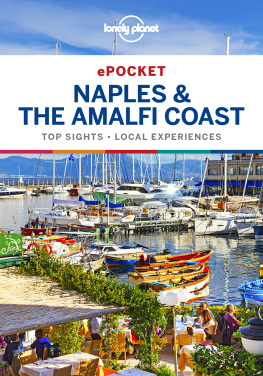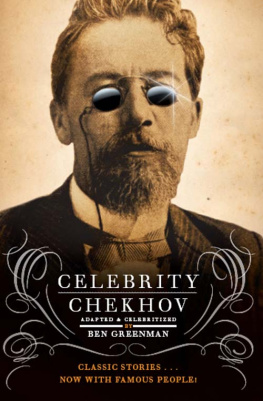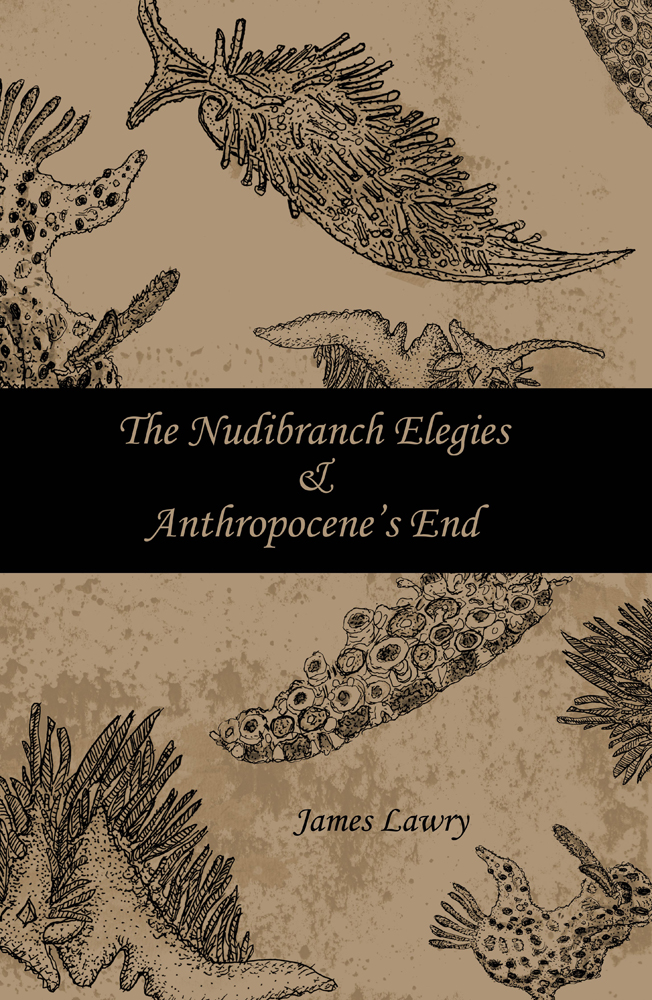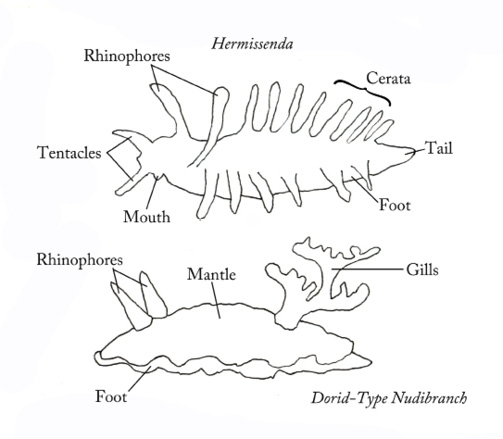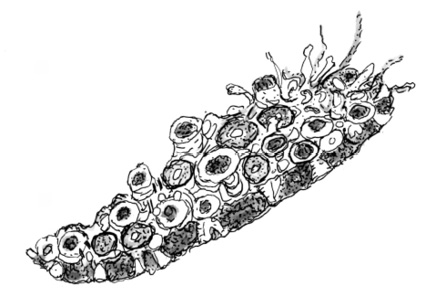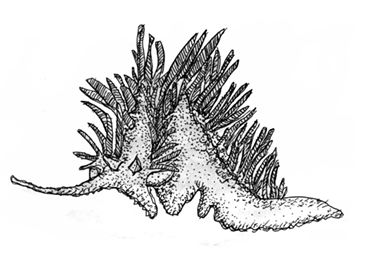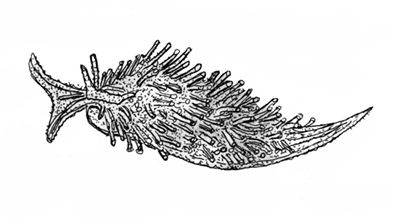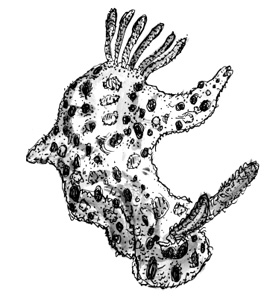Contents
The Nudibranch Elegies and Anthropocenes End
James Lawry
Regal House Publishing
Copyright 2018 James Lawry. All rights reserved.
Published by Regal House Publishing, LLC Raleigh, NC 27612 All rights reserved
Printed in the United States of America
ISBN -13 (paperback): 978-1-947548-24-4 ISBN -13 (hardcover): 978-1-947548-42-8 ISBN -13 (epub): 978-1-947548-25-1 Library of Congress Control Number: 2018934036
Interior design by Lafayette & Greene Cover design by Lafayette & Greene lafayetteandgreene.com Cover and interior images by James Lawry
Regal House Publishing, LLC https://regalhousepublishing.com
For: Hermissenda, Anton, Ed Ricketts & Jaynie
When you collect marine animals there are certain flat worms so delicate that they are almost impossible to catch whole for they will break and tatter under the touch. You must let them ooze and crawl of their own will onto a knife blade and lift them gently into your bottle of sea water. And perhaps that might be the way to write this book-to open the page and let the stories crawl in by themselves.
John Steinbeck, Cannery Row The Elegies: An Overview Germany, 1862.
At Jena University Anton Dohrn studies marine invertebrates under Ernst Haeckel, who explains to him Darwins Theory of Evolution. Ernst developed a recapitulation theory of evolution that hypothesizes that during embryological development every animal passes through the evolutionary stages of its predecessors. Anton travels to Naples, Italy, to study marine invertebrates in the Bay of Naples and discovers new beauties: the nudibranch Hermissenda and the Grotta Azzura, the Blue Grotto on the island of Capri. In Naples Anton establishes the Stazione Zoologica, a Marine Zoological Research Station where visiting zoologists from all over the world assemble to study and learn together. Anton falls in love with Hermissenda. In the library of the Stazione he discovers ancient writings in her Nudibranchian Language.
Anton translates these into German and writes his Nudibranch Elegies. The Nudibranchs The nudibranchs are an ancient group of soft mollusks or sea-slugs from the Cambrian Era, that evolved about four hundred and fifty million years ago. Nudibranchs live only in the sea and breathe through open or naked gills [ nudus , naked, brankhia ,
gills]. Nudibranchs probably arose from snails, lived on hard surfaces, and scraped up their food. They lose their shells during their larval stages when they swim freely as veligers. Adult nudibranchs are hermaphrodites that display wonderfully changing shapes and fragile diaphanous colors.
The natural colors of nudibranchs are hard to preserve satisfactorily even on film. Anton urges us to look at the animals because human theories are never final. It is only with clear eyes and an open mind can we discover how
invertebrates and nudibranchs live. Antons drawings and writings convey new wonders to be found in the sea, and that awe enriches each new eye, heart, and mind that searches patiently and intently for a new understanding. Be relentlessly curious. Start with the details.
Learn how the earth breathes. Each year thousands of plant and animal species disappear. We shall never meet or know them. Our children will never see them. Today, they seem to be leaving forever.
Dendrodorus: Her body is black, sometimes with cream or white spots.
Dendrodorus: Her body is black, sometimes with cream or white spots.
Her rhinophores carry elongated white knobs at their tips. The edges of her mantle are frilly; the remainder of her body is soft and delicate.
Flabellina , our Spanish dancer, is a very colorful aeolid nudibranch. Her cerata are orange or yellow. Her body is purple or bluish.
Hermissenda , Antons lover, is a brightly colored nudibranch.
Hermissenda , Antons lover, is a brightly colored nudibranch.
She normally lives on the West Coast of North America and Mexico, but as a veliger larva she traveled to the Mediterranean in a ships bilges.
Hypselodorus , A dorid nudibranch from the
Atlantic and Mediterranean. Discovery On a shelf in the basement of the library of Jenas Academy of Sciences behind bound copies of the (1895) Jenaische Zeitschrift fuer Naturwissenschaften , I found old drawings and manuscripts together with chips of marble statues and pieces of dried ancient kelp taken from a cave in Capri. The eggs of Nudibranchs, encased in amber, shimmered under my microscope. In awe I deciphered a new language from crumbling pages. Scrawled in a strange alphabet: the letters the shapesof the cells of marine algae and hydroids.
I was discovering glorious things their ancient authors never intended for me to see. Drawn to these speckled and stained fragments my heart and fingers pieced together a record all the way back to the Cambrian Era. Nudibranchs had dappled time with many silences, but a few had written and signed their names: Hypselodoris, Hermissenda, Flabellina, Dendrodorus .
I could scarcely believe that Nudibranchs had lived in our oceans for eons. After extreme labor I set their writings over into my native German.
Note: Nudibranchs lay their eggs in flat ribbons or masses attached to rocks, kelp, algae or other objects on the sea bottom.
Note: Nudibranchs lay their eggs in flat ribbons or masses attached to rocks, kelp, algae or other objects on the sea bottom.
I love the Nudibranchian language:
Soft, fluid, opalescent As quiet as Flabellinas kisses. Satin syllables murmur Of Mediterranean summers Sweep in and out in swirls Around stones in the ebbing tide. Not a single eddy tastes Uncouth.
Anton Dohrn Our Translations from the Nudibranchian
1. Dendrodorus: The grotto was now empty. Here I found poor Hermissenda .
Emptiness had gotten bored with itself and her. Flabellina had torn poor Hermissendas foot from her cerata, And pulled her severed body around as if she were a sled. Hermissenda , frightened, now barely alive, had everted herself like one of those crazy Holothurians, had pulled herself out of herself too quickly, too roughly, too violently, so that one rhinophore had been torn completely away, the blue one at its ring. I could see it there on the sand this little pipewriggling like a worm.




